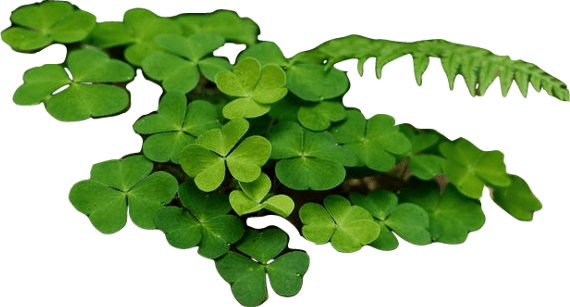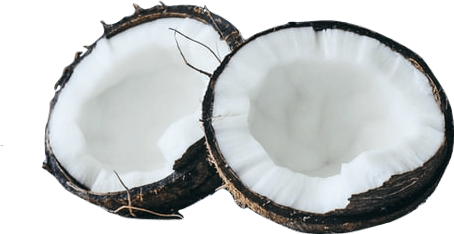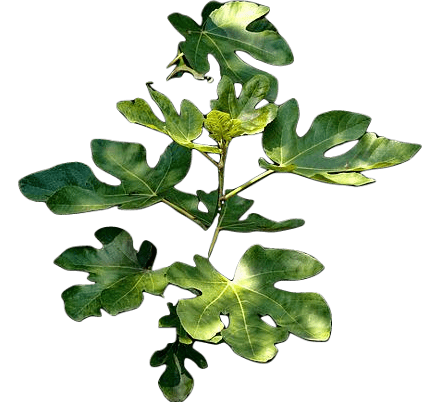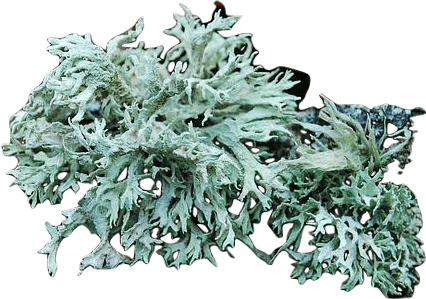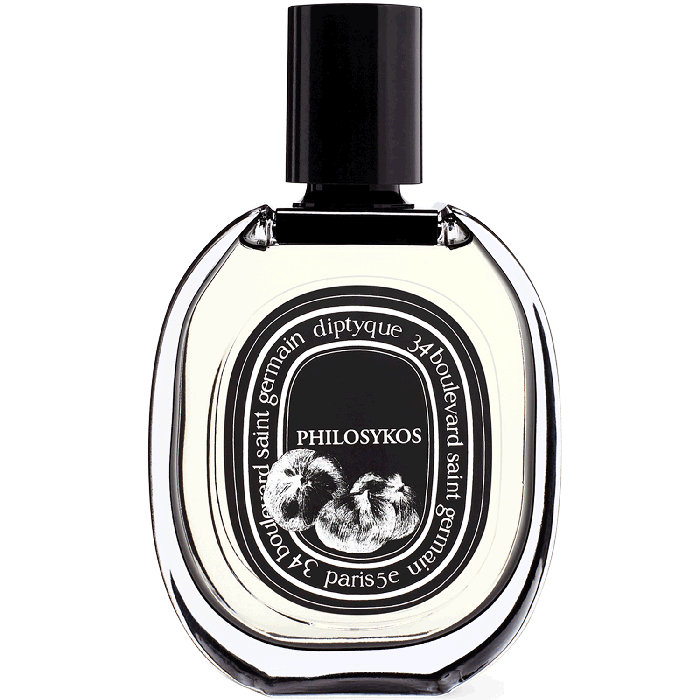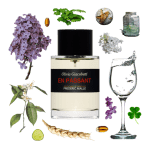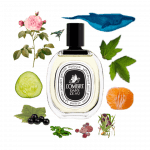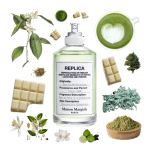Philosykos Eau de Parfum by Diptyque Review
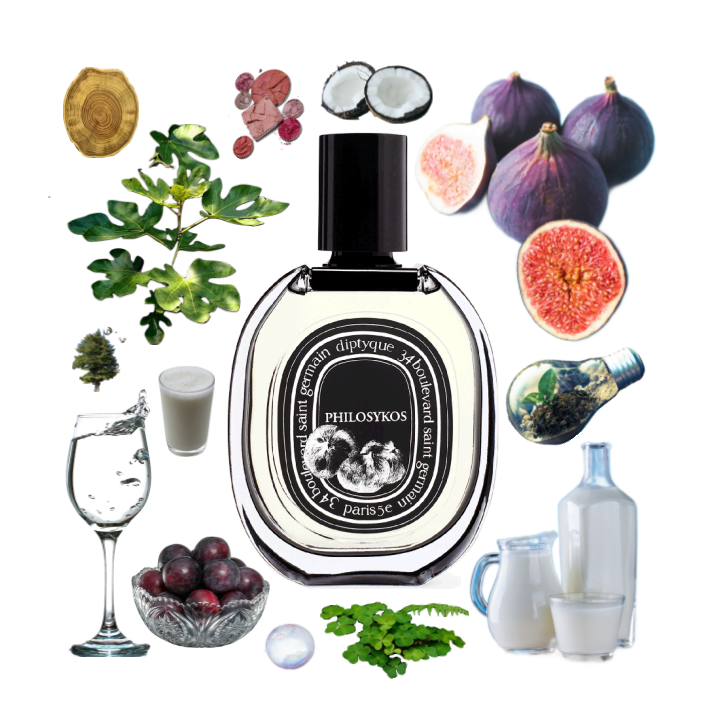
Oh, how one’s opinions can change over time.
When I first tried Philosykos EdP, I was enormously disappointed. I’d built up the fragrance in my mind, certain that this was going to be my gorgeous signature for all time. It looked and sounded beautiful, after all: green and wet and rainy and figgy, a contemplative scent for a humid, cloudy day.
I love figs and rain and green scents. I loved the meaning of the name (“friend of the fig tree” in Greek). It appealed to both the romantic and the classicist in me, making me think of late night walks and leather-bound old books and heated conversations about nothing at all.
I eagerly awaited the arrival of my sample… and then was sorely disappointed. The bright, clean sappiness of the composition was repulsive to me. Its squeaky-clean milkiness made me think of the sort of scent you’d give a pack of diapers or baby wipes.
I rarely do this, but here I think it might be beneficial to quote my original, very critical review of Diptyque’s Philosykos EdP in its entirety as a sort of counterpoint to what follows:
How is it that the ones you’re most excited to try sometimes turn out to be the biggest letdowns?
I love green, wet, woody notes and I love figs. I don’t think Philosykos EDP is for me. There’s no coconut listed in the notes pyramid, but this fragrance feels primarily coconutty in some way; not like sunscreen, but, rather, like the dry brown husk of a coconut, along with something milky, sappy, oozy and laconic. It’s defending [sic] interesting and different, with a convincing suggestion of a fresh, underripe fig among greens and oozy sap. Somehow, however, between the coconut, the nondescript white twig milk, and the fresh fruit, this comes off feeling, to me, like some sort of baby product, like powder or wipes, or maybe even some sort of fancy organic cotton diaper sold at Whole Foods.
The individual components of this scent delight and intrigue me, but, together, on me, the effect is one of very clean and powdery products for infants. I accidentally got a touch of Olene on my fingers as I opened this vial, and the clean white florals meld perfectly with this clean, fruity scent, with the flowers blending and covering the baby powder aspects of Philosykos EDP. Together, they’re still not something I’d want to wear, but, at least, something more interesting than baby powder.
I’m not one to usually care about sillage, but this is almost an instant faint skin scent, and I expect more of an EDP. It’s all but gone in just 4 hours, too, which is the sort of silly longevity I might tolerate in a scent I like, but not in something so middling and faint.
There is something in this that I find repulsive on me, in a fruity, sappy, lactonic way. I love fresh figs, but perhaps I would not love to smell like one. I want more twigs and leaves and dirt. That being said, there’s something impressive in how they get that fresh underripe fig and white sap just right. This is a unique fruity scent, and one I can appreciate for its cleverness. On me, though, I just can’t stop smelling some sort of too-clean baby product.
Also, I think something in this makes me cough? I’ve never had that reaction to a fragrance before, so I’m not sure what that’s about. I suspect this one is just bad with my skin chemistry and my nose, which is unfortunate, as I wanted to like it so much. You Philosykos enthusiasts can keep this one.
In short, I was crushed. I was confused. I felt betrayed.
And then, somehow, everything changed.
I don’t remember exactly when or how it happened. I tried Philosykos EdP in the fall, felt bitterly disappointed and repulsed, and put it aside for the winter. But something about Philosykos always nagged at me. It always felt like I wasn’t quite finished exploring the scent — that it would be perfect, just perfect if not for the weird baby-powder effect of that pervasive fig sap note that stubbornly stuck with me the whole way through. It felt like, if only I could put that difference aside, Philosykos and I could be best friends.
To quote John Green’s Fault in Our Stars, “I fell in love [with Philosykos] the way you fall asleep: slowly, and then all at once.”
One day I brought her back out in the springtime. Rainy days always make me think of Philosykos, and on one such rainy day I decided to give her another chance.
And wow, did she flourish. Philosykos is a fundamentally damp, humid, rainy sort of scent. Contemplative yet hopeful, the perfume needs the thick air after the rain, the dripping from the leaves, to really perform its best. Suddenly, I felt I was a little more part of everything around me. The whole world was dripping wet and picturesque and green, and so was I. In the damp air, smells carried, and the trees in springtime smelled lovely, just slightly sweet in that woody way, and I was right there alongside them.
The way humidity magnifies scents makes rainy days a highly coveted commodity on my perfume-wearing calendar. All sorts of favorites battle it out for the gorgeous magnification of a damp and dripping day.
Every time it rains I think of Philosykos, and, more often than not, she wins the contest for what to wear that day. I often deliberate between her and Guerlain’s Mitsouko, that sulking melancholy goddess that also really flourishes in air that’s heavy with clouds. That’s high praise and good company, especially for a perfume I originally gave a rather middling review.
So, Philosykos, my beloved, let’s start over, shall we? Let’s go back to the beginning and see what you have for me on this gorgeous gray rainy day.
In the vial, I smell a concentrated greenish sort of woody bitterness. On skin, this bitterness explodes into a crackling pile of fresh twigs, bending and snapping. This is Philosykos EdP at its freshest, its greenest, its snappiest, an explosion of fig sampling twigs and leaves.
In just a minute, another note begins to rise through the ranks of fresh green snapping twigs. I can only really describe it as kind of lactonic, but in a plant-y way. This rich, milky scent is the sap of the fig tree, and it is the note that, on me, plays the central role in this composition. It’s almost pungent, simultaneously very clean and rather sharp in its contours. This is the note I described as a too-clean, powdery sort of baby wipe scent.
It doesn’t smell at all like playdough, but I can only liken the effect to that of playdough-y vanilla scents: they come on very strong, very distinct, concentrated without apology, embracing the weird flourishes of taking the note to this extreme. Some people love it, embracing the decadence and supernatural indulgence of it all, while others condemn it, treating that doughy artificial undertone as the sign of a bad vanilla.
The distinct bitter-powder-and-sweet-nectar scent of fig tree sap is like a divisive doughy vanilla. It pulls no punches. It’s thick and powerful, making me think of gooey white sap dripping out of a rubber tree. It doesn’t smell at all like dairy but its texture is almost milky, somehow, in the same way alternative plant milks imitate the mouthfeel of cow’s milk without embracing its flavor.
Indeed, perhaps some of that milkiness comes from the subtle creamy infusion of coconut. I was quite apprehensive about this note. Coconut makes me think of sun and lotion and of flowers like lilac, datura, and lily. It makes me think of a decadent indulgence that can work in a summery floral context, but feels like it must be a cliché obligatory “tropical” note in something green. It didn’t help that my most recent experience with a coconut note had been in Serge Lutens’ Datura Noir, where I feel that bizarre note shattered the effect of the composition with uninvited summer-fun sunscreen-like levity.
I needn’t have worried. I don’t pick up anything that smells distinctly like coconut in Philosykos EdP. Instead, it seems the creamy facets of coconut milk have been blended into the sap, building out the milky white accord as the centerpiece of the perfume.
Paired with the fresh green snapping twigs and leaves of the fig tree, the sap is freshened slightly, made lighter and more diffuse. It’s airy with a clean brightness to it that keeps the note miraculously floating in the air without crossing into artificial-laundry-cleaner territory or cliché calone-y hell.
Within two hours, the sap has lost its most distinct and pungent edge. It becomes more about soft, silky, musky texture than about conveying a very specific scent note. It fills the space in Philosykos, cradling the fruit, green, and woody notes in its midst.
Much like the 2019 hit miniseries Good Omens, Philosykos flirts with, but ultimately circumvents overt fruitiness in favor of subtler, more restrained suggestions. This simply isn’t a fruit-forward perfume — at least, not on me. I don’t get a prominent whiff of succulent fresh figs, of the golden nectar that gathers in a drop at the bottom of them, of the stewy rich smell of fig puddings and jams, or even of spicy dried figs. This isn’t a Mugler Womanity or even a Le Labo The Noir 29 sort of fig.
If there’s anything of the fig fruit here, it’s the delicate, watery aroma of freshly washed plump purple and green figs. It’s the slight bitterness, milkiness, and sappiness of their outer skin, of that deceivingly bitter and fibrous outer layer that holds the incredibly sweet red fig nectar inside. Much like the delectable mango note in Hermès’ Un Jardin sur le Nil, this is the restrained scent of the outside of a fruit, rather than a decadent sugary romp in its sweetest ambrosia.
The fig fruit here is a certain pale surface dustiness, a bitter fuzziness to the outside of the fruit, paired with a faint trickle of sweetness that peers out through the bitter and musky layers of the fig tree. This is no drug store tropical-fruit-scented body spray. It isn’t cut fruit served on a ceramic platter, or a fig-flavored gum, or a fancy Greek drink. It’s a discrete suggestion of figs in the tree around you, hiding just behind those snappy green leaves and that dripping white sap.
I am reminded, as I am often, of that gorgeous passage in The Bell Jar about the overwhelming nature of abundant choices:
“I saw my life branching out before me like the green fig tree in the story. From the tip of every branch, like a fat purple fig, a wonderful future beckoned and winked. One fig was a husband and a happy home and children, and another fig was a famous poet and another fig was a brilliant professor, and another fig was Ee Gee, the amazing editor, and another fig was Europe and Africa and South America, and another fig was Constantin and Socrates and Attila and a pack of other lovers with queer names and offbeat professions, and another fig was an Olympic lady crew champion, and beyond and above these figs were many more figs I couldn’t quite make out. I saw myself sitting in the crotch of this fig tree, starving to death, just because I couldn’t make up my mind which of the figs I would choose. I wanted each and every one of them, but choosing one meant losing all the rest, and, as I sat there, unable to decide, the figs began to wrinkle and go black, and, one by one, they plopped to the ground at my feet.”
Sylvia Plath, The Bell Jar
Of course, we often quote that lovely passage out of context, don’t we? On the very next page, our protagonist confesses:
“I don’t know what I ate, but I felt immensely better after the first mouthful. It occurred to me that my vision of the fig tree and all the fat figs that withered and fell to earth might well have arisen from the profound void of an empty stomach.”
Sylvia Plath, The Bell Jar
Oh, the wonders a good meal can do.
And so, Philosykos avoids the misery of the fig tree metaphor. It feeds you with plump figs while leaving you marveling at the expansiveness of the future, the beauty of abundance and choice. It’s a scent of wonder, and perhaps a dram of indulgent melancholy, but nothing that isn’t fixed by a hearty meal and a refreshing walk in the rain.
The faint sweetness of the fig fruit isn’t really a prominent player until about an hour into the fragrance. It comes out more in cooler rooms and in the evening breeze. The hotter and more humid the environment around me is, the more the bitter green twigs and musky white sap dominate the perfume.
At times, in a cool, air-conditioned room, the nebulous waft of fruity fig in Philosykos EdP feels almost like plum. This is similar to an effect I get in Chloé’s Nomade, where that gorgeous yellow mirabelle plum starts turning into something more like fig in the drydown. It seems these two fruit notes tend to evaporate in similar ways over time, leaving a lovely nebulous scent that, when combined with amber base notes, could be either a milky fig or the lightest hint of sweet plum.
A few hours in, only a whisper of that snapping green freshness remains. The dripping white sap has softened with time, getting silkier and muskier. It blends with a faint hint of figgy sweetness to create a sort of “my skin but better” effect.
It’s comparable to the effect of the late drydown of a subtle musky amber or woody perfume, when you can’t quite tell anymore what’s perfume and what’s the natural sweetness of your skin underneath. This might partly be aided by the nondescript woody notes hidden in the very base of the fragrance. I don’t get any distinct woods, but scents like oak tend to have this effect on me, the sorts of woods that seem solid and bitter at first blush and then mellow into a shy wispy sweetness hours later on your skin.
That silky-soft, almost musky, almost woody scent of sweetened sap is the last thing to evaporate. It’s a tail that lasts an hour or two, not a long tail like some amber-ish bases, but a phase as transient as every other part of this scent.
There’s an inherently humid nature to Philosykos EdP. It’s green in a way that’s irreparably wet, like a rainforest or a washed bowl of fruit or a field after the rain. This quality is what makes Philosykos really sing on rainy days and on cloudy gray afternoons, in late summer humidity and early spring damp. It makes me think of the rains of early spring and autumn. They hang in the air, the petrichor rising in a thick cloud of warning all around you. They’re loud and gorgeous. This is the pitter-patter of raindrops gently rolling off tiny new leaves onto the ground, with frogs croaking in the background. It’s a walk where you intentionally leave your umbrella behind.
Philosykos is the rain that makes everything more lush, more verdant. It’s the way film producers often spray water on outdoor sets before filming, bringing out the color in everything, making the grass greener and the air sparklier. It’s the muted rumbling of a thunderstorm outside as you wait for the clouds to clear enough to go out for a stroll.
The rich green humidity of Philosykos is impressively realistic compared to other offerings in perfumery. Though there’s no floral or artificially-maintained quality here, that humidity reminds me of what I think of as conservatory floral notes. These are rich floral accords that hang around you like water droplets, making me think of a lush greenhouse or botanical garden.
The floral notes in Guerlain’s Mitsouko EdT and EdP have this humidity, as do the cold narcissus blooms of Amouage’s Myths Woman. Unlike these, however, Philosykos feels humid in a fundamentally outdoor way. There’s something too sweet, too gentle, too subtle and musky about it to be recreated by humans in a greenhouse. It’s a cool sort of humidity, a heaviness of water droplets hanging in the air as a cold breeze brushes past your cheek.
This is a signature Olivia Giacobetti composition. It’s clean and green, distinctly watery in a way that isn’t quite the usual definition of aquatic. Philosykos is my favorite exploration thus far of Giacobetti’s clean, green, watery theme. This clean freshness tends to lean a little bit too clean for my tastes in some other very pretty compositions of hers, such as Frederic Malle’s En Passant.
Don’t get me wrong, Philosykos is still super clean. Nothing here is really earthy or overwhelmingly hard to swallow. But the faint bitteress of twigs and the pungent musky nature of the coconut-laced sap makes this a fundamentally green experience instead of a bluish one. It doesn’t rely on a blue calone-fresh note like lotion-y cucumber for freshness; instead, here is a sense of new spring growth and geosmin-laced damp air, of pitter-pattering and petrichor.
Philosykos is clean like a world washed by rain instead of like a skin product with the word “fresh” in its name. It’s more realistic and multi-dimensional than that, with surprising depth packed into its ephemeral lifespan. Giacobetti brilliantly goes for sappy rather than soapy, and that has made all the difference.
At a paltry four hours, the longevity of Philosykos is admittedly rather pathetic for an Eau de Parfum. There’s no two ways about it: projection-wise, this is weak. I can only imagine how weak the Eau de Toilette must be in comparison. It’s probably the weakest in my collection of samples I truly adore and bring out often. Philosykos gets a pass for its excellent composition, but that performance really makes me hesitate when it comes to buying a larger decant.
Still, Philosykos is fundamentally a delicate composition. I can’t imagine many ways to make it last longer without weighing it down. Adding more fixative base notes would likely make this too much of an amber-forward scent (though it would be interesting to see this blended with a hint of oakmoss). Going the cheap-but-loud calone freshness route, on the other hand, would shatter the gauzy effect of the perfume entirely. Philosykos is fundamentally diaphanous and ephemeral. If it stuck around all day, it wouldn’t be Philosykos anymore.
Thus, this perfume scores rather low on practicality and cost-effectiveness for me, though it gets high marks for uniqueness and sheer artistic beauty. Despite all my griping, I know I’ll use my sample up and then order more, shoving my nose into my wrist for hours on end to try to get a whiff of that lovely fig tree.
Where to Find Philosykos Eau de Parfum by Diptyque
You can find samples, decants, and full bottles of Philosykos EdP at Scent Split.
This is an affiliate link. If you click on it and buy something, the seller pays me a commission, at no extra cost to you. You can learn more about them here.



